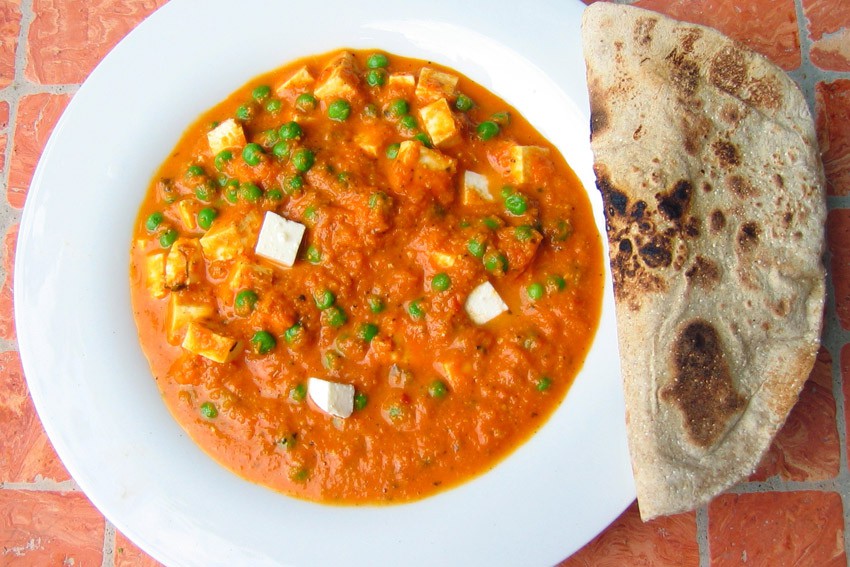Cheese Matters: Panir

Ragini Dey is the energetic personality behind Dhaba at the Spice Kitchen. I recently met with her at the Leabrook restaurant where she revealed the tradition of panir cheese. This fresh, acid-set curd cheese is widely used in Indian cuisine.
Ragini Dey was born into a middle-class family in Mirzapur, India. She grew up in Delhi having a sense of regional food boundaries partly due to her parents.
Her father was from Bengal and her mother from the north of India. Her food has been influenced by the regional styles she grew up with at her parents’ table. Ragini’s food has an exceptional balance of spices and flavour, which she says comes from years of experimenting and an uncompromising approach. The traditional fresh Indian cheese panir (also known as paneer, and chaana in Bengal) can be grilled, used fresh, braised or baked. It is high on Ragini’s list of ingredients.
She explains: “Dairy is a big thing in India, everyone eats cheese, they make their own yoghurt and love cream. Historically, culturally and socially, milk is very important in India.” Each household has a milking cow tethered to their verandah, she explains. “Milk is food from the gods and anything that comes from there is very precious and appreciated.” Buffalo, goat and camel’s milk also all play a part in this exotic cuisine.
In India, panir is used in hundreds of savoury dishes; it also forms a large part of many variations of sweet dishes and desserts. As people have become busier the tradition of making panir at home is not as popular as it was in the past. Ragini says that the “freshness and sweetness of a freshly made panir is worth the time and the relatively small amount of effort required to make it.
When I was growing up the modern conveniences of today just weren’t available and people would make their own. You could buy it in some stores, but it was frowned upon.” She explains that “homemade is always better” and relates it to buying a packaged spice mix of Rogan Josh. Back in the day this was unheard of.
“No one would touch such a thing, especially in India,” she explains. “You would buy the whole spice and you would always grind it yourself. Indeed we would take our wheat to the local mill for freshly milled flour for the household.” She questions the direction of this progress around food. “India has become more modern but some things haven’t changed. The shoeshine man is still there, but now he has a mobile phone to take all his bookings.”
Ragini’s Panir (makes 250 grams)
Ingredients:
Two litres milk and 60ml white vinegar
Method
1. Line a large mesh strainer with a clean square of muslin (cheese cloth).
2. Put the milk in a large heavy-based saucepan over medium heat and bring to boil.
3. Remove from the heat and stir in vinegar.
4. Continue stirring until the milk starts to separate and curd forms. This should take about a minute.
5. Pour the liquid into the strainer lined with muslin, so that the whey drains away and the curd is caught in the muslin.
6. Bring in the corners of the muslin to meet at the centre and tie a knot.
7. Transfer the bundle to a large bowl and sit a plate, which will f t inside the bowl, directly onto the bundle, weighed down with two-to-three cans.
8. Leave for about 30 minutes, or until the panir is firm.
9. Remove the panir from the muslin and immerse it in a large bowl of cold water.
10. In an airtight container, store covered in water in a refrigerator for five to seven days.
Panir can be used in curries, stuffing, dips, snacks and dessert. Different acid agents can be used to curdle, or separate, the milk producing different textures. You could try lemon or lime juice, whey, yoghurt or buttermilk. Panir can be hung instead of pressed to give a different texture and consistency, suitable for desserts.
This simple cheese features strongly on Ragini’s menu. I shared a variety of panir with her, each with a slightly different flavour and texture. What stood out was the fresh milkiness and clean flavour. Somewhere between a firm cottage cheese and soft feta style is the way I would describe it.
The real treat, however, was sampling the traditional dishes where the cheese was combined with other flavours. Cheese pakoras filled with panir, coriander and saffron, curries with solid little cubes of panir and rasgulla (a panir-based, syrupy dessert) were among my favourites. Ragini was 26 when she arrived in Australia.
She established Dhaba at The Spice Kitchen in 1992, where she continues to create and explore a tapestry of flavours and tradition in her kitchen. Her new book Spice Kitchen from Ganges to Goa is a must have for lovers of Indian cuisine.
Kris Lloyd is the Head Cheese Maker of Woodside Cheese Wrights woodsidecheese.com.au